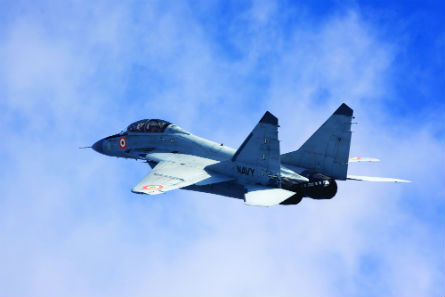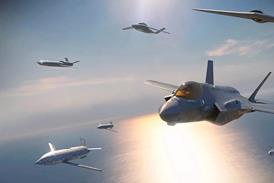After two decades of stagnation, Russia's defence aerospace industry has at last received several major lifts from its domestic customer. Major production orders have been signed for almost 250 new combat and training aircraft, and deals are due to follow for an expected 400 more under Moscow's current 10-year re-armament package.
Worth about 20 trillion roubles ($617 billion) until 2020, the initiative is a much-needed measure to refresh the equipment being used by the Russian armed forces. Equally, it underlines a desire from the state to revive and safeguard the prospects of several of the nation's most historic companies.
Among the systems to have been ordered in the past few months are 92 Sukhoi Su-34 long-range bombers - adding to 34 previously under contract - 48 Su-35 fighters and 30 Su-30SM strike aircraft for the air force, along with an earlier deal to supply 55 Irkut-manufactured Yakovlev Yak-130 advanced jet/combat trainers to the service.
The Russian navy, meanwhile, will get 20 RAC MiG-29K carrier-based fighters and an accompanying batch of four MiG-29KUB trainers under a deal inked in February.
 |
|---|
| RAC MIG 20 RAC MIG's have been ordered by the Russian navy |
"The large orders that we have gained within the framework of the Russian state armament programme will be a big boost for the aerospace industry, and for industrial stability," says Mikhail Pogosyan, chief executive of the United Aircraft (UAC) group of companies.
"In the previous 10 years, the development of military aviation was largely determined by the orders which came from our foreign customers. The next 10 years will be a boost for the development and deep modernisation of the existing fourth-generation fighter aircraft and the technological development and building of the fifth-generation aircraft.
"It is a good background for growth for the overall United Aircraft capabilities in the military segment," says Pogosyan, who is also the chairman of Sukhoi.
The order for Su-35 fighters could be of particular significance, as it could potentially lead to future success in offering the type to other users. "We believe the experience of operation within the fleet will bring a stimulating effect for promoting the aircraft outwards. It is a good sign for the export market when they see the operation of the aircraft in the domestic air force," says Pogosyan. The type has previously been unsuccessfully offered to Brazil, but has more recently attracted interest from China.
For the longer term, Russia's defence ministry is expected to soon approve the production start for Sukhoi's next-generation PAK-FA/T-50 fighter, as the first performance-testing examples are expected to reach the air force next year. About 250 are likely to be procured over time for domestic use. This total will be expanded under a joint effort with India, which plans to acquire about 200 adapted examples via its fifth-generation fighter aircraft (FGFA) programme.
"A joint team made up of Indian and Russian experts are now defining their requirements for certain systems, but it's premature today to speak more precisely," Pogosyan says. Engineering personnel from Hindustan Aeronautics were already working on the FGFA project in Russia earlier this year in conjunction with Sukhoi.
In the past, UAC has outlined an ambition to increase sales of the PAK-FA to 600 aircraft via exports. "We stick to the previous target - it's quite enough for this programme to be economically effective," says Pogosyan, who took the top position at the company in February 2011. "But later on we will develop this aircraft further, and maybe there will be more."
Pogosyan points to Sukhoi's previous experience with the Su-27/30 family of combat aircraft as a possible indication of wider long-term success for the new-generation fighter; first flown in prototype form in January 2010. "At the initial stage of that programme we expected to sell about 1,000 aircraft. Many years later, new members like the Su-34 and Su-35 have good prospects. The family is still in development," he notes.
Deliveries made during 2011 included Su-30-series aircraft for Algeria, India, Uganda and Vietnam.
Roughly 770 Su-27/30-series aircraft are in active use today, as recorded by Flightglobal's MiliCAS database, with the largest fleets being with the air forces of China, India and Russia.
Two Su-27s from the latter's Russian Knights aerobatic display team are due to be at the Farnborough air show, with one to participate in the daily flying display. Their visit is timed to occur less than a month before the Russian air force commemorates the centenary of its formation, with the service's new Yak-130 to also be on show in the UK for the first time.
Not all elements of the next generation of Russian air force equipment have been finalised, with firm details about two key strike components still in short supply. A previously proposed ground-attack variant of the Yak-130 has been ruled out, with Moscow having decided to fund the development of a dedicated replacement for its Su-25s instead.
The pursuit of a next-generation bomber to replace the Tupolev Tu-95 and Tu-160 has also been the subject of intense discussion recently, after deputy prime minister Dmitry Rogozin cast doubt on the proposed PAK-DA's utility in future conflict.
The official, who has special responsibilities for Russia's military-industrial complex, caused headlines - not by discussing the likely vulnerability of a future manned bomber against advanced air defence systems, but by contradicting president Vladimir Putin.
Rogozin subsequently adapted his statements to highlight the prohibitively high costs that would be associated with developing any aircraft akin to the US Air Force's Northrop Grumman B-2 stealth bomber, which has an estimated through-life unit cost of about $1 billion.
Other future projects will include the development of large unmanned air vehicles, with early activities to advance the expertise of local industry being undertaken with Israel. A move to field unmanned combat air vehicles is also a possibility.
Also in the military arena, series production of a modernised version of the venerable Ilyushin Il-76 transport is expected to commence in 2013-2014. This will follow flight testing, which is expected to commence around mid-year from Aviastar's production plant in Ulyanovsk.
UAC also continues to make preparations to launch the production of the Antonov An-70 in co-operation with Ukraine. "There are no deals right now, but it will be ordered," says Pogosyan, who expects at least a combined 100 to be produced for the air forces of Russia and Ukraine.
Although greatly delayed, any production decision would offer up a rival to the Airbus Military A400M Atlas on the international stage. "After we have the first operational experience with this [An-70] aircraft, we also expect to have some external sales," Pogosyan says.
Another collaboration, this time with India, will also lead to the delivery of a smaller Medium Transport Aircraft (MTA) product, with a payload capacity of 15-20t. Design activities are being performed by Irkut and Hindustan Aeronautics, with the latter expecting the type to draw sales of about 205 aircraft: 100 for Russia, 45 for India and 60 for "third countries".
"We have made a lot of effort recently to boost this programme and make it move quicker than the previous several years. We have prepared a really solid foundation," says Pogosyan.
As with the partnership with India on the PAK-FA/FGFA combat aircraft, the MTA initiative has received solid support from the Russian state.
"The aerospace industry is a driving force for any economy," says Irkut president Alexey Fedorov, who preceded Pogosyan as the top official at UAC. "The Russian government sees as one of its major goals to develop the aerospace industry - not just for the sake of the aerospace industry, but also to develop our technologies and industrial potential. Our major task is to preserve the place we hold in the military market, while also getting back to the positions we have lost in building civil aircraft as well."
Two current commercial aerospace programmes will each play pivotal roles if the latter ambition is to be achieved: the Sukhoi Superjet regional aircraft and Irkut's narrowbody MS-21.
Due to be on show at Farnborough again following a high-profile debut in 2010, the Superjet has just cleared its first year of revenue operations with launch user Armavia, and also with Aeroflot. Despite a fatal accident involving the type during a demonstration flight in Indonesia in May, Pogosyan is confident many more users will go on to introduce the currently up to 95-seat design.
Now in its detailed design phase and due to be flown for the first time in 2014, the MS-21 will come in three versions, capable of seating between 150 and 210 passengers.
Both are coming to the market during a period of major growth in demand for domestic and international air travel, and as Moscow urges operators to retire their remaining Soviet-era equipment.
"We are sure that such a rapid growth of passenger traffic and the innovative product that we are offering to the market [with the MS-21] will bring the opportunity for a third player to appear" behind Airbus and Boeing in the narrowbody sector, Pogosyan says.
Russia has yet to reach the end of the path required to move its industry and aircraft offerings to such a lofty position, but Pogosyan says the progress made during UAC's short history suggests it can complete the transition.
"We understand that the process of integration into a big company is not a one-leap process," he says, pointing to the experience seen by other major players in Europe and the USA, such as EADS and Boeing.
"This process will take time, but for the five years that the corporation has existed, the volume of production of the aircraft has doubled." In 2011, its combined output totalled 110 aircraft worth about $5.5 billion.
"We are doing a great job in seeking commonality in technical solutions for different kinds of products, which gives us an opportunity to move further and quicker," he says.
"Through the search for commonality in products and in customer support, we look to the prospect of promoting not just a product made by a single company, we are looking to promote consolidated product lines, with some commonality between them: in military, commercial and transport.
"Maybe the fruits of the re-organisation are not so evident right now, but what we are doing here today brings optimism," Pogosyan says. "And a doubling of sales - it's not a bad result for the initial stage."
Source: Flight International























